![]()
![]()
![]()
Use LEFT and RIGHT arrow keys to navigate between flashcards;
Use UP and DOWN arrow keys to flip the card;
H to show hint;
A reads text to speech;
216 Cards in this Set
- Front
- Back
|
Frontalis |
Raises eyebrows |
|
|
Occipitalis |
Retracts skull |
|
|
Orbicularis oculi |
Closes eyelid |
|
|
Levator palpebrae superioris |
Opens eyelid |
|
|
Nasalis |
Flares nostrils |
|
|
Orbicularis Oris |
Pucker up for kissing |
|
|
Orbicularis Oris |
Pucker up for kissing |
|
|
Levator labii superioris |
Elevates upper lip |
|
|
Zygomaticus major |
Smiling |
|
|
Zygomaticus major |
Smiling |
|
|
Risorius |
Grimace |
|
|
Zygomaticus major |
Smiling |
|
|
Risorius |
Grimace |
|
|
Depressor anguli Oris |
Frowning |
|
|
Zygomaticus major |
Smiling |
|
|
Risorius |
Grimace |
|
|
Depressor anguli Oris |
Frowning |
|
|
Depressor labii inferioris |
Depresses lower lip |
|
|
Mentalis |
Pouting |
|
|
Mentalis |
Pouting |
|
|
Buccinator |
Sucking |
|
|
Platysma |
Tenses nexk |
|
|
Medial rectus |
Crosses eye |
|
|
Medial rectus |
Crosses eye |
|
|
Lateral rectus |
Turns eye laterally |
|
|
Medial rectus |
Crosses eye |
|
|
Lateral rectus |
Turns eye laterally |
|
|
Superior rectus |
Elevates eye |
|
|
Inferior rectus |
Depresses eye |
|
|
Levator palpebrae superioris |
Opens eyelid |
|
|
Pectoralis major |
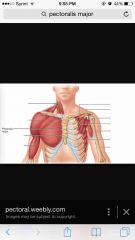
Back (Definition) |
|
|
Pectoralis major |
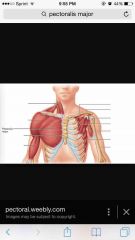
Back (Definition) |
|
|
Pectoralis minor |
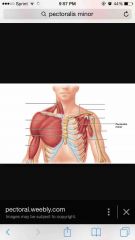
Back (Definition) |
|
|
Deltoid |

Back (Definition) |
|
|
Rectus abdominus |
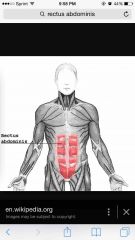
Back (Definition) |
|
|
External oblique |
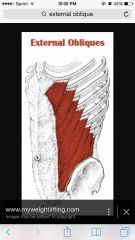
Back (Definition) |
|
|
Internal oblique |
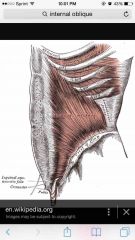
Back (Definition) |
|
|
Transversus abdominus |
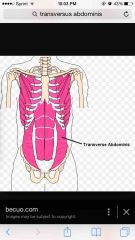
Back (Definition) |
|
|
Digastric |
Opens mouth |
|
|
Digastric |
Opens mouth |
|
|
Mylohyoid |
Elevates floor of mouth |
|
|
Trapezius |
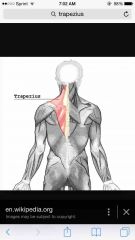
Back (Definition) |
|
|
Trapezius |
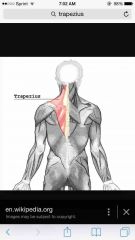
Back (Definition) |
|
|
Rhomboideus major and minor |

Back (Definition) |
|
|
Latissimus doris |

Back (Definition) |
|
|
Splenius capitis |
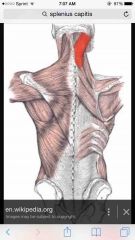
Back (Definition) |
|
|
Splenius capitis |
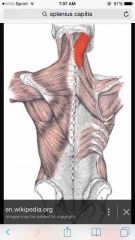
Back (Definition) |
|
|
Semispinalis |
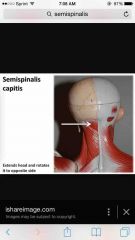
Back (Definition) |
|
|
Teres minor |

Back (Definition) |
|
|
The cells primarily responsible for the remodeling of bone are |
Osteoclasts |
|
|
What are the contributed to variation between skeletons? |
Level of activity during life Nutrition Disease Trauma and injury |
|
|
An adolescent grows in height mainly because of events that occur in the ___ of the skeleton |
Metaphyses |
|
|
What part is not part of the axial skeleton |
The clavicles |
|
|
The ___ of a vertebra bears the most weight |
Body |
|
|
Which are the vertebrochondral ribs? |
Ribs 8-10 |
|
|
The trochlea of the humerus articulates with |
The proximal ulna |
|
|
Through what opening does the spinal cord pass? |
Vertebral foramen |
|
|
Which bone points toward the little finger |
Metacarpal V |
|
|
Which bone points toward the little finger |
Metacarpal V |
|
|
Which of the following features is NOT a part of the humerus? |
Radial tuberosity |
|
|
What is a pivot joint? |
Radioulnar joint |
|
|
If you are sitting on a sofa and raise your own arm to rest it on the back of the sofa, what action must occur at the shoulder joint? |
Abduction |
|
|
What if you stood flat-footed, with heels apart but toes touching each other. You would be exhibiting |
Medial rotation of the hip |
|
|
What is it called when you put the soles of your feet together? |
Inversion |
|
|
In a relaxed muscle fiber, active sites of actin are blocked by |
Tropomyosin |
|
|
Which of the following is considered to be a regulatory protein of the myofilaments? |
Troponin |
|
|
What is the name of the opening where spinal nerves leave and enter the spinal cord? |
Intervertebral foramen |
|
|
What is the name of the opening where spinal nerves leave and enter the spinal cord? |
Intervertebral foramen |
|
|
What structure stores calcium ions that trigger contraction? |
Sarcoplasmic reticulum |
|
|
A smile is produced by contraction of the ____ muscle |
Zygomaticus major |
|
|
The deepest muscle of the abdominal wall is |
The transverse abdominus |
|
|
In which of the following muscles would you expect the motor units to be the smallest? |
Superior oblique |
|
|
Function of bones |
Blood cell production Movement Support and protection Storage of mineral and energy reserves |
|
|
Growth in diameter of thickness |
Appositional growth |
|
|
Growth in length |
Interstitial growth |
|
|
Dense irregular connective tissue covering the outer surface of bone |
Medullary cavity |
|
|
Dense irregular connective tissue covering the outer surface of bone |
Periosteum |
|
|
Hollow, cylindrical space within the diaphysis, contains bone marrow |
Medullary cavity |
|
|
Region between diaphysis and epiphysis, contains the growth plate |
Metaphysis |
|
|
Which part of the epiphyseal plate is anchored to the epiphysis? |
Zone of resting cartilage |
|
|
Which cervical vertebra lacks a vertebral body? |
C1 the atlas |
|
|
A carpal bone is classified as a ____ bone in terms of shape |
Short |
|
|
The clavicle is which part of the skeletal division? |
Appendicular |
|
|
The inorganic portion of the bone tissue is made up of what mineral salt? |
Hydroxyapatites |
|
|
The long bones of the body develop by ___ ossification |
Endochondral |
|
|
The ___ on the rib attached to the body on the vertebra and the ___ on the rib attached to the transverse process on the vertebra |
Head, cervical |
|
|
When you pronate your hand, what happens to the distal end of the radius? |
Distal end becomes more medial |
|
|
Name the depression in the ulna into which the humerus inserts |
Trochular notch |
|
|
Give 3 names for rib 12 |
False rib, floating rib, vertebral rib |
|
|
Layer of self a timer all internal surface of the bone |
Endosteum |
|
|
What structure makes up the vertebral arch? |
The pedicles and laminae |
|
|
What are the names of the Fibrocartilage pads found between adjacent vertebrae? |
Intervertebral disc |
|
|
The superior articulating process of the vertebra articulates with what specific structure |
Inferior articular process |
|
|
A rip that attaches to the sternum by the cartilage of rib seven has what name? |
Vertebrochondral rib, one of the false ribs |
|
|
What is the inferior portion of the sternum called |
Xiphoid process |
|
|
How do you tell C 7 for T1 |
Spinous process |
|
|
Name the carpal bone at the base of the thumb |
Trapezium |
|
|
Name 2 sesamoid bones |
The patella and pisiform |
|
|
What is another name for the big toe? |
Hallux |
|
|
What is another name for the thumb? |
Pollux |
|
|
Which type of cartilage is found in the intervertebral disc? |
Fibrocartilage |
|
|
What number do we get to the big toe and the thumb? |
Roman numeral 1 |
|
|
How many bones are in the ankle (tarsal)? |
7 tarsal bones |
|
|
How many bones are in the wrist? |
8 carpal bones |
|
|
How many spines do we identify on the os coxa? |
5 spines |
|
|
What specific bone bears the most of our weight when we sit? |
Ishium |
|
|
Which muscle tissues have striation? |
Skeletal and cardiac |
|
|
Which muscle tissues have to be stimulated by nervous system? |
Smooth muscle and skeletal muscle |
|
|
A sarcomere extends from a ____ to a ____ |
Z line to Z line |
|
|
The proteins that make up the middle of the sarcomere are called the |
M line |
|
|
What is the immediate source of energy for the mitochondris in the muscle cells |
Glycogen |
|
|
Where does hemopoiesis occur? |
Red bone marrow |
|
|
The synaptic end knob is on the ____ and the motor end plate is on the ____. |
Nerve, muscle |
|
|
Which muscle tissue is under voluntary control? |
Skeletal muscle |
|
|
What is the difference between endomysium and sarcolemma? |
Endomysium is a layer of areloar ct and contains capillaries and nerves. Sarcolemma is a cell membrane |
|
|
The word brachii tells a location. Where is this location? |
Humerous |
|
|
What are the 4 rotator cuff muscles? Can you see the tendon "cuffs" on the proximal end of the humerus? |
Teres minor, infraspunatus, supraspinatus, and subscapularis. Yes |
|
|
Cells that produce new bone tissue by secreting matrix are called |
Osteoblasts |
|
|
What is not a function of cartilage? |
Synthesizes red blood cells |
|
|
Which would not be classified as an irregular bone? |
Scapula |
|
|
The zones found in the epiphyseal plate are? |
Calcified cartilage Hypertrophic cartilage Ossification Resting cartilage Proliferating cartilage |
|
|
The correct order for the zones found in the epiphysis closest to the edge is |
Resting cartilage Proliferating cartilage Hypertrophic cartilage Calcified cartilage Ossification |
|
|
What is another name for bone salt? |
Hydroxyapatites |
|
|
The occipital condyles articulate with the? |
Atlas |
|
|
Transverse foramina are found in _____ vertebrae |
Cervical |
|
|
The intramembranous ossification is formed by what? |
Ribs, flat bones of the skull, vertebrae |
|
|
5 vertebrae; fuss into a single bony structure in adults |
Sacrum |
|
|
5 vertebrae; fuss into a single bony structure in adults |
Sacrum |
|
|
4 vertebrae; also called the "tailbone" |
Coccyx |
|
|
5 vertebrae; fuss into a single bony structure in adults |
Sacrum |
|
|
4 vertebrae; also called the "tailbone" |
Coccyx |
|
|
12 vertebrae; form the superior regions of the back |
Thoracic vertebrae |
|
|
5 vertebrae; fuss into a single bony structure in adults |
Sacrum |
|
|
4 vertebrae; also called the "tailbone" |
Coccyx |
|
|
12 vertebrae; form the superior regions of the back |
Thoracic vertebrae |
|
|
7 vertebrae; form the bone of the neck |
Cervical vertebrae |
|
|
The slender curved bone that is located inferior to the skullbetween the mandible and larynx is the ____ bone |
Hyoid |
|
|
The vertebral processes that are most easily palpated along the midline of the back are the ____ processes |
Spinous |
|
|
Bones of the palm of the hand |
Carpals |
|
|
Bones of the palm of the hand |
Carpals |
|
|
Bones of the digits |
Phalanges |
|
|
Bones of the palm of the hand |
Carpals |
|
|
Bones of the digits |
Phalanges |
|
|
Bones of the wrist |
Metacarpals |
|
|
The prominence on the inferior side of the sternal end of the clavicle is called the ____ |
Costal tuberosity |
|
|
Also known as the kneecap |
Patella |
|
|
Also known as the kneecap |
Patella |
|
|
Form the arched portion of the foot |
Metatarsals |
|
|
Also known as the kneecap |
Patella |
|
|
Form the arched portion of the foot |
Metatarsals |
|
|
Medial bone of the leg |
Tibia |
|
|
Also known as the kneecap |
Patella |
|
|
Form the arched portion of the foot |
Metatarsals |
|
|
Medial bone of the leg |
Tibia |
|
|
Form the ankle and proximal foot |
Tarsals |
|
|
Also known as the kneecap |
Patella |
|
|
Form the arched portion of the foot |
Metatarsals |
|
|
Medial bone of the leg |
Tibia |
|
|
Form the ankle and proximal foot |
Tarsals |
|
|
Form the toes |
Phalanges |
|
|
Also known as the kneecap |
Patella |
|
|
Form the arched portion of the foot |
Metatarsals |
|
|
Medial bone of the leg |
Tibia |
|
|
Form the ankle and proximal foot |
Tarsals |
|
|
Form the toes |
Phalanges |
|
|
Lateral bone of the leg |
Fibula |
|
|
Which of the following features is the most proximal feature of the ulna |
Olecranon |
|
|
The type of fibrous joints that are in mobile are found only between certain bones of the skull are called |
Sutures |
|
|
___ synovial joints are diarthroses |
All |
|
|
Which of the following fibrous joints allow for slight movement and the articulating bones are joined by long strands of dense regular connective tissue |
Syndesmosis |
|
|
A place where a bone connects another bone is called an |
Articulation |
|
|
Intercarpal articulations are ____joints that permit gliding movement between individual carpal bones |
Plane |
|
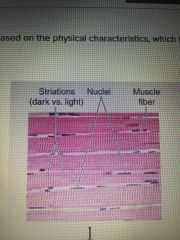
Which muscle tissue is this |
Skeletal muscle |
|
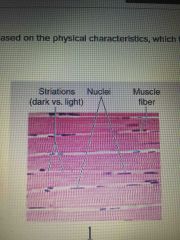
Which muscle tissue is this |
Skeletal muscle |
|
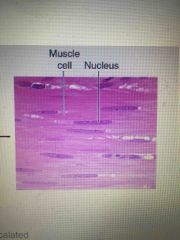
Front (Term) |
Smooth muscle |
|
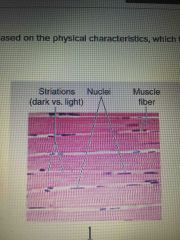
Which muscle tissue is this |
Skeletal muscle |
|
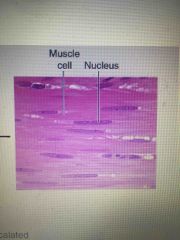
Front (Term) |
Smooth muscle |
|
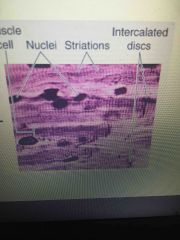
Front (Term) |
Cardiac muscle |
|
|
Ability to extend in length |
Extensibility |
|
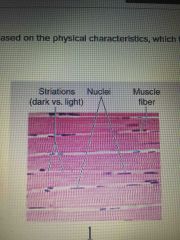
Which muscle tissue is this |
Skeletal muscle |
|
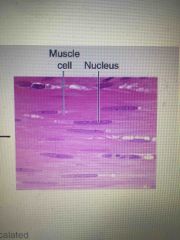
Front (Term) |
Smooth muscle |
|
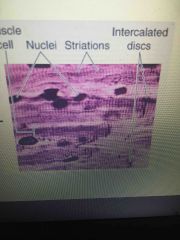
Front (Term) |
Cardiac muscle |
|
|
Ability to extend in length |
Extensibility |
|
|
Ability to respond to stimuli |
Excitability |
|
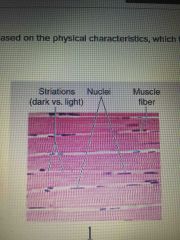
Which muscle tissue is this |
Skeletal muscle |
|
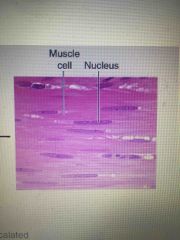
Front (Term) |
Smooth muscle |
|
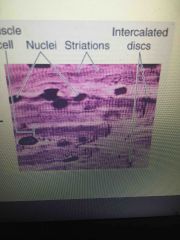
Front (Term) |
Cardiac muscle |
|
|
Ability to extend in length |
Extensibility |
|
|
Ability to respond to stimuli |
Excitability |
|
|
Active generation of force |
Contraction |
|
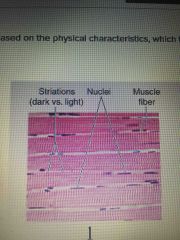
Which muscle tissue is this |
Skeletal muscle |
|
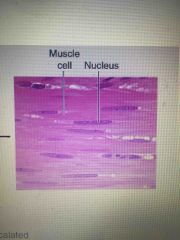
Front (Term) |
Smooth muscle |
|
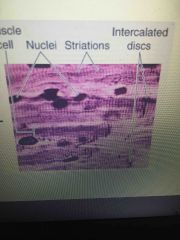
Front (Term) |
Cardiac muscle |
|
|
Ability to extend in length |
Extensibility |
|
|
Ability to respond to stimuli |
Excitability |
|
|
Active generation of force |
Contraction |
|
|
Ability to return to original length after being stretched |
Elasticity |
|
|
Surrounds the fascicles |
Perimysium |
|
|
Surrounds the fascicles |
Perimysium |
|
|
Surrounds each muscle fiber |
Endomysium |
|
|
Surrounds the fascicles |
Perimysium |
|
|
Surrounds each muscle fiber |
Endomysium |
|
|
Surrounds the whole skeletal muscle |
Epimysium |
|
|
A nursing baby uses what muscle |
Buccinator |
|
|
What is the linea alba? |
A narrow, vertical, fibrous strip used to attach muscle sheaths of the left and right rectus abdominis |
|
|
Zone of resting cartilage |
Anchors growth plate to epiphysis |
|
|
Zone of proliferating cartilage |
Chondrocytes multiply |
|
|
Zone of proliferating cartilage |
Chondrocytes multiply |
|
|
Zone of hypertrophic cartilage |
Chondrocytes enlarge |
|
|
Zone of proliferating cartilage |
Chondrocytes multiply |
|
|
Zone of hypertrophic cartilage |
Chondrocytes enlarge |
|
|
Zone of calcified cartilage |
Matrix becomes calcified |
|
|
Zone of proliferating cartilage |
Chondrocytes multiply |
|
|
Zone of hypertrophic cartilage |
Chondrocytes enlarge |
|
|
Zone of calcified cartilage |
Matrix becomes calcified |
|
|
Zone of ossification |
Bone |

